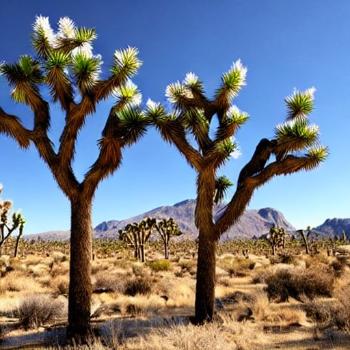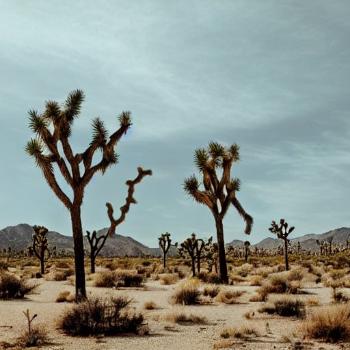Do Joshua Trees Grow Anywhere Else? Joshua trees grow exclusively within the Mojave Desert, primarily in California, Nevada, Utah, and Arizona, with their range extending only between elevations of 400 and 1800 meters (1300-5900 feet).
The Mojave Desert, which includes the principal habitat of the Joshua trees, is an arid region that bears the name of the native Mojave people. There is no evidence of their occurring naturally anywhere in the globe. These trees have established a niche for themselves in this particular desert ecosystem, where their development is conspicuously missing from other areas.
Additionally, it is known that Joshua trees serve as a recognizable sign that the Mojave Desert is nearby. Although seldom reaching 40 feet (12 meters), their towering formations, which may grow to heights of 20 to 70 feet (6 to 21 meters), add to the region’s unique environment. They coexist alongside saguaro cactus in the Sonoran Desert, but the vast grasslands of the Mojave, particularly in places like Queen Valley and Lost Valley, continue to be their actual habitat.
Joshua trees are considered to be long-lived species due to their longevity; researchers believe some California trees to be approximately 1,000 years old. This trait further demonstrates their enduring affinity for the Mojave Desert and the unique growing circumstances it provides. They have a reputation for being very low-maintenance trees because to their adaption to the unique conditions of the desert.
Joshua Trees: Not Just In The Mojave Desert
Joshua trees, commonly found in the mojave desert, are not restricted to this arid region alone. They can also be found in parts of nevada, utah, and arizona. These unique trees have become synonymous with the mojave desert due to their distinctive appearance and ability to adapt to the harsh desert conditions.
Named after the biblical figure joshua, they have an almost mythical quality, standing tall with their spiky leaves reaching towards the sky. Their sturdy branches host a variety of wildlife, including birds and insects, making them an essential part of the desert ecosystem.
While the majority of joshua trees can be found in the mojave desert, it is fascinating to discover that they can thrive in other areas as well. Their resilience and beauty make them a truly remarkable plant species.

The Natural Habitat Of Joshua Trees
Joshua trees are unique to the mojave desert due to its exceptional environmental conditions. They are not found anywhere else, thriving in the arid landscape of this expansive desert ecosystem. The mojave desert offers the ideal climate and weather for joshua tree growth, with its hot and dry summers and mild winters.
These trees have adapted to the harsh conditions, with their hardy nature enabling them to survive in low rainfall and high temperatures. The mojave desert provides the necessary elements, such as well-drained soil and ample sunlight, for joshua trees to flourish.
It is fascinating to explore this ecosystem and witness the remarkable resilience of these iconic trees.
Unexpected Joshua Tree Populations

Joshua trees, known for their unique appearance, are not limited to the joshua tree national park. Surprisingly, these iconic trees can be found in unexpected locations. One such place is the colorado desert, where joshua trees thrive despite the region’s harsh conditions.
Another fascinating fact is that variations of the joshua tree species can be found in mexico, showcasing the adaptability of these resilient plants. The great basin, too, is home to its own population of joshua trees. These remarkable trees have managed to establish themselves in diverse and sometimes surprising environments.
Their ability to grow in different locations highlights their tenacity and adds to the intrigue surrounding these captivating desert dwellers.
The Challenges Of Thriving In Different Environments
Joshua trees are uniquely adapted to the challenging environment of the mojave desert. These trees have evolved various strategies to survive in this arid region. However, their ability to thrive outside the mojave desert is limited due to specific factors.
Firstly, joshua trees depend on a delicate balance of temperature, precipitation, and soil conditions, which are not easily replicated in other locations. Additionally, their reproductive cycle is closely tied to the mojave desert’s unique climate patterns, making it difficult for them to reproduce elsewhere.
Furthermore, human impact poses a significant threat to joshua tree habitats. Urban development, agriculture, and climate change all contribute to the shrinking of suitable habitats for these trees. Despite these challenges, efforts are being made to protect and conserve joshua trees both within and beyond their natural range.
Conservation Efforts To Protect Joshua Trees
Do joshua trees grow anywhere else besides their famous namesake national park in california? Conservation efforts play a crucial role in protecting these unique trees. Preserving joshua tree populations is of utmost importance. Conservation strategies are implemented to safeguard their habitats.
Promoting awareness and education about joshua trees is also vital. By educating the public about their significance and ecological importance, we can encourage a sense of responsibility. Additionally, collaborative efforts between governments, organizations, and communities help ensure the conservation of these iconic trees.
Protecting joshua tree habitats not only benefits the trees themselves but also supports the overall ecosystems they are a part of. As we continue to understand the value of conserving joshua trees, we can work towards securing their future for generations to come.
Frequently Asked Questions For Do Joshua Trees Grow Anywhere Else
Can Joshua Trees Be Found Outside Of Joshua Tree National Park?
Yes, joshua trees can be found outside of joshua tree national park. They are native to the mojave desert and can be found in areas of southern nevada, southwest utah, and northwest arizona. Some joshua trees have also been cultivated in regions with similar climates around the world.
Do Joshua Trees Grow In Any Other Countries?
No, joshua trees are native to the united states and can only be found in certain regions within the country. They are most commonly found in the mojave desert, which spans parts of california, nevada, utah, and arizona. While they may be cultivated in other countries with similar climates, they do not naturally grow elsewhere.
Are There Any Endangered Species Of Joshua Trees Outside Of Their Native Habitat?
No, the joshua tree (yucca brevifolia) is not considered an endangered species. However, due to factors such as climate change and habitat loss, some joshua tree populations are facing threats. Efforts are being made to protect and preserve these iconic desert trees through conservation measures and land management practices.
Are There Any Alternative Names For Joshua Trees?
Yes, joshua trees are also known by their scientific name, yucca brevifolia. Additionally, some people refer to them as yucca palms, yucca trees, or even tree yuccas. These alternative names may be used interchangeably to describe the unique and distinct characteristics of this iconic desert species.
Conclusion
Joshua trees are primarily found in the mojave desert region of the southwestern united states. While they have become an iconic symbol of the desert landscape, these unique and fascinating trees also have a limited range. Despite their name, joshua trees are not exclusive to joshua tree national park and can also be found in small pockets in other regions, such as the pahrump valley and the mojave national preserve.
However, they do not grow in abundance outside of their natural habitat due to specific climatic and soil conditions required for their survival. As we continue to learn more about these remarkable trees, it is crucial to protect and preserve their natural habitats, ensuring the continued existence of these stunning and ecologically important species.
So, while joshua trees may not grow anywhere else in large numbers, their beauty and significance can be admired and celebrated in the unique desert ecosystems they call home.
Also Read :
26 Interesting Facts About Joshua Trees
References:
https://palmdesert.ucr.edu/calnatblog/2021/11/08/all-about-joshua-trees-keystone-species
https://www.nwf.org/Educational-Resources/Wildlife-Guide/Plants-and-Fungi/Joshua-Tree
